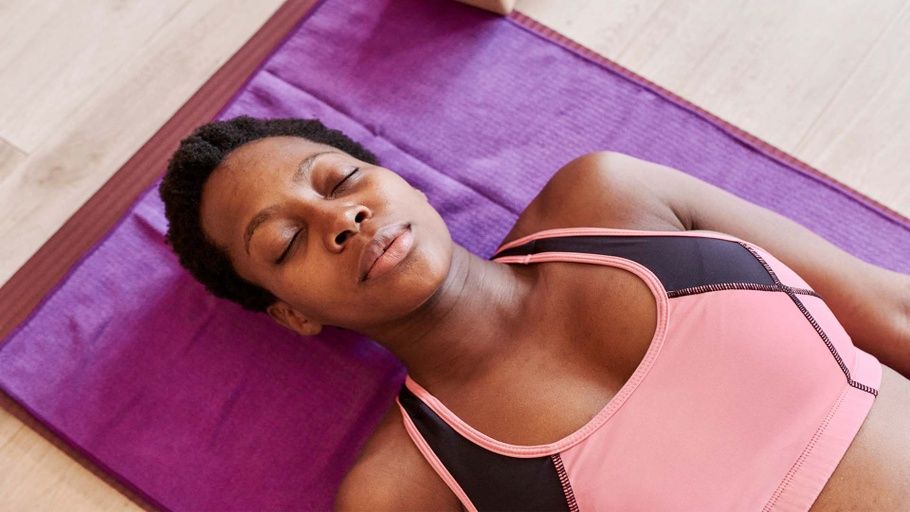Yoga nidra is a proven method for bolstering mental health and particularly successful for people looking to manage anxiety and work through trauma. Learn more about how this practice can become a rejuvenating ritual for your mental well-being and an empowering tool for healing.
Twenty-five years ago, Greg Wieting lived with anxiety, depression, chronic pain, and scoliosis. Today, he stands three inches taller and says he no longer struggles with his mental health like he did in the past. He credits his healing to yoga nidra.
“Before finding yoga nidra, I was fighting against the pain, fighting against the curve in my spine, trying to get it forcefully to open and shift, which was me coming at myself from a lack of acceptance,” says Wieting, whom DailyOM interviewed for this article. “Yoga nidra was a gift that allowed me to rest inside myself, not fight against myself, not try to fix or change anything but settle into myself. Yoga nidra helps us have that pause to take time and space to just be with ourselves.”
Following his personal experience in using yoga nidra for healing, Wieting created PRISMA — a framework overlaying trauma, neuroscience, and energy medicine with somatic and mindfulness-based practices. He specializes in helping others heal from anxiety, depression, and chronic pain rooted in trauma using yoga nidra.
It is from this place of simply resting and being with ourselves through yoga nidra that true healing can begin, shares Wieting.
What Is Yoga Nidra?
Yoga nidra, or “yogic sleep,” is a form of yoga that embraces rest — dating back to 1000 B.C. but formally introduced to the public in the 1960s. Yoga nidra is tied to the Sankhya philosophy, which says that happiness lies in being able to separate the observer from what is being observed (thoughts, emotions, sensations, other beings).
Lying on the floor, you are guided into a deep level of relaxation called a “hypnagogic state,” where the physical body goes into a level of deep sleep even though the mind is alert and awake. Yoga nidra differs from meditation since it reaches this hypnagogic state, while meditation typically stays in a wakeful state and is more commonly (though not always) done sitting up rather than lying down.
It is in this hypnagogic state of deep relaxation that the body shifts toward “parasympathetic dominance,” bringing about a slower heart rate that reduces anxiety and promotes more restorative sleep following the practice, according to a study published in the International Journal of Yoga. The parasympathetic nervous system works in opposition to the sympathetic nervous system (the part that controls our flight-or-fight responses). Therefore, parasympathetic dominance gives the sympathetic nervous system (aka the stress or anxiety we might be feeling) permission to chill out.
Yoga nidra also helps restore the hippocampus, a small, curved formation in the brain that assists with the formation of new memories, learning, and emotions. “While a strong hippocampus dampens our stress response, a weak hippocampus makes us more susceptible to anxiety and depression,” Haley Perlus, PhD, an author, speaker, and adjunct professor at the University of Colorado who specializes in sport and performance psychology explains to DailyOM.
Just 11 minutes of a yoga nidra practice each day has the ability to reduce stress and improve sleep.
As yoga nidra removes stress hormones, it strengthens this part of our brain and makes us better equipped to handle anxiety and depression.
“When participating in yoga nidra, we practice control of our breathing, posture, and mental activity. This results in the activation of the hippocampus and prefrontal cortex,” says Dr. Perlus. “Together, this allows us to have better concentration [and] more control over emotions, and makes us more aware of our senses.”
Additional research shows that yoga nidra triggers a 65 percent increase in the release of another neurotransmitter: dopamine — also known as the “feel good” hormone — which causes blood vessels to relax, helps with sleep, and boosts your mood.
Interested in learning more? Check out Awaken Your Chakra Energy
How Can Yoga Nidra Help With Mental Health?
Jobs, relationships, mortgages, caregiving, pandemics, natural disasters ... the stress we encounter on a day-to-day basis can feel relentless. Which means that caring for your mental well-being has become as crucial as caring for your physical well-being. And being proactive about mental health has never been more important — at any age. The Anxiety and Depression Association of America estimates that nearly 19 percent of adults and 32 percent of adolescents between the ages of 13 and 19 struggle with an anxiety disorder. The World Health Organization estimated a 25 percent global increase in anxiety during the COVID-19 pandemic, and JAMA Pediatrics reports that anxiety and depression rates doubled among youth during the pandemic.
But the good news is that research in recent years has validated yoga nidra and other forms of meditation as an effective technique to help sustain positive mental health, especially for those who struggle with anxiety, stress, and depression.
A study conducted over the course of three months on college professors with diagnosed anxiety and depression found that yoga nidra was the most effective (compared to seated meditation and a control group) in reducing anxiety.
“During yoga nidra, serotonin and GABA [two neurotransmitters that impact our moods] are released, producing anti-depressant and anti-anxiety effects. When done with regularity, high levels of these neurotransmitters can be maintained, which will help your brain and body fight depression and anxiety,” explains Perlus. “Yoga nidra also improves our sleep habits, and lack of sleep and depression are often related.”
While most yoga nidra practices are about 45 minutes long, research from the journal Current Psychology suggests that just 11 minutes of a yoga nidra practice each day has the ability to reduce stress and improve sleep. Perlus recommends practicing yoga nidra at least several times a week for its physical and mental benefits. “For those who struggle with daily anxiety or are facing extreme pressure, practice yoga nidra daily,” says Perlus.
How Can Yoga Nidra Help With Trauma?
An eight-week study with combat veterans suffering from post-traumatic stress disorder found that yoga nidra “reduced rage, anxiety, and emotional reactivity, and increased feelings of relaxation, peace, self-awareness, and self-efficacy, despite challenges with mental focus, intrusive memories, and other concerns,” as reported to the International Journal of Yoga Therapy.
Why is this the case?
The more you practice yoga nidra, the more the benefits of the practice will carry over into your daily life — taking you out of “flight-or-fight” mode more often and giving your body ample opportunities to rest and heal.
“If we start to slow down, we become that much more aware of our pain rather than rush over it,” says Wieting. “When there’s trauma, the nervous system gets short-circuited and [our health] gets distorted. Yoga nidra is something to break up that noise, to attune to and align with our innate wisdom so that we can heal.”
An ancillary benefit of yoga nidra is that it also provides connection with the person guiding you and the ground beneath you.
“Trauma can lead to isolation and lack of support. But that is where yoga nidra is very powerful,” says Wieting. “It can help create a loving environment to help us slow down, process, and heal with the earth beneath us to support us.”
What’s the Best Yoga Nidra Practice for You?
Though yoga nidra is shown to be helpful for those with pain, anxiety, or trauma, it is beneficial for anyone who needs a little stress management (or just wants an opportunity to rest!). And it’s absolutely okay to practice at home with an audio guide. The most important thing is to find a yoga nidra class or guide who resonates with you, so it may take a few tries to find the right one.
If you are working through trauma, Wieting stresses the importance of finding a yoga nidra practice or instructor who is trauma-informed and who can help you handle any strong emotions that might arise during the practice.
It’s also important to acknowledge that any healing process takes time and patience, and the journey will be ongoing. And don’t be discouraged if your yoga nidra practice — especially in the beginning — ends with you falling asleep. (That’s why Perlus recommends not doing yoga nidra immediately after a meal, since this will make you more likely to fall asleep.) But even if sleep happens, Wieting notes that sleep may be the body’s way of getting the deep healing it needs.
Stay consistent with your practice and, above all, be kind and patient with yourself, the experts advise.
Wieting’s healing has come a long way, yet he continues to prioritize yoga nidra as part of an ongoing self-care routine.
“Although I still have a curve in my spine, there is no chronic pain and anxiety. I’ve developed a capacity to be in a loving relationship with and nurture this experience [of healing],” Wieting says. “How can we acknowledge our needs and get them met more skillfully, more lovingly? [Healing] is really about responding to our needs.”

